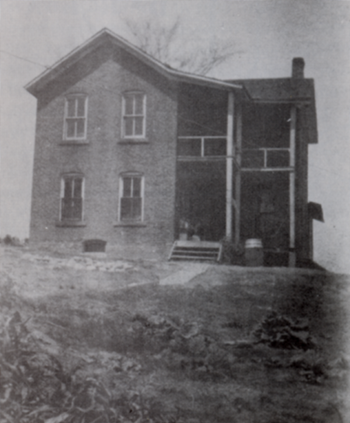Court Fight Over Land
Jacob Frederick died June 14, 1852. In his will, Frederick first specified that the small library he had assembled be sold and the money collected be sent to Washington to aid in building the monument to honor “the great, good and illustrious Washington.” Frederick also specified that upon the death of his wide, Judah, his land containing about 745 acres on his farm and 114 acres with his saw mill and his money be divided among his sons and daughters: Joanna Firestone, James M. Frederick, John S. Frederick, B. Franklin Frederick, Faney Smith, and Sabena Ellison.
Smith and Firestone were living in Ohio, and James M. and John were settled in Portland, Oregon. B.F. remained in the area and farmed. After a lengthy court battle against estate executors Isaac Cooper and Thomas Mitchell, B.F. won a good portion of his father’s land. The remaining portion of the farmland was divided into parts of equal value, sold at public sales, and the proceeds divided among Frederick’s other heirs. Those purchasing Frederick land included Edward and Sarah Hooker, James J. Fredregill, John C. Taylor, Thomas K. Brooks, and John O’Connor.
B. F. Frederick continued to run a large farm operation. He exhibited his sheep at fairs and later, in 1857, he raised the first sorghum in the county. New settlers, such as Benjamin F. Allen, R. C. Webb, Edward J. Ellison, and George C. Boggs, also began operating farms, Industry was also started. J. J. Fredregill, James Shakelford, N.B. Cooley, and a Fisher all started brickyards at one time or another. From the clay of the eastern banks of Four Mile Creek, bricks were formed then fired in huge kilns. The job was not without hazards as there is at least one reported death, that of Ed Fredregill who was killed when a kiln exploded.
The Coming of the Trains
The economic activity of the area changed with the coming of the railroads. Portions of the Frederick estate were granted as right-of-ways to three railroads. The Mississippi and Missouri Railroad Company purchased a right-of-way in 1853 and soon laid a track, but real development began after the Civil War. The Des Moines Valley Railroad Company purchased a right-of-way in 1866 and built a track, and the Chicago, Rock Island, and Pacific Railroad Company bought a right-of-way to lay track in 1867. (These two rail lines, both now part of the defunct Rock Island Lines, run mostly north-south on the west side of town.)

On April 13, 1847 the area was officially designated Four Mile Township. (However, the boundaries of the new township were not the same as those of the present Four Mile Township The place for holding elections was fixed at the houses of Jacob Frederick, and he, Montgomery McCall, and Napier were appointed judges.
The coming of the railroads may have helped increase settlement in the area. In1860, the U. S. census counted 462 persons in Four Mile Township. By 1870, the population of the township was listed as 513. Settlers then included J. G. Warnock, Stephen A. Breown, Mrs. Lucy Prentice, L. D. Sims, Calvin Thornton, and J. N. Wilkins.
Four Mile Township went through a number of changes since its founding in 1847. As the population of the county grew, various townships were created from parts of the existing ones. Four Mile lost land in 1848,1851, and 1858. Then, in 1870, to honor President U. S. Grant, a major part of Four Mile Township (including Four Mile Creek) and all of Lee Township outside of Des Moines became Grant Township.